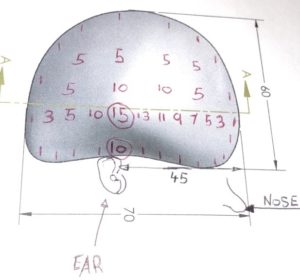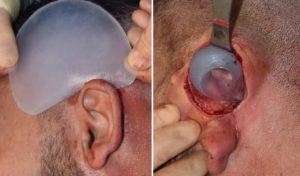Background: There are various general descriptions of head shape concerns which imply which section of the skull is either excessive or deficient. A narrow head shape refers to the side of the head which is commonly perceived as that of the temporal bone which sits above the ear. Technically it also includes a portion of the parietal bone at its upper and posterior extent as well. But the temporal bone occupies the majority of what is perceived as the side of the head.
Unlike the rest of the head where the skull bone is responsible exclusively for its shape, the side of the head’s shape is heavily influenced by the temporal muscle. This broad fan-shaped muscle fills the side of the head from the temporal fossa up across the temporal bone posteriorly. While a bulk of the muscle resides in the deeper temporal fossa area, up to one-third of it stretches across the side of the head over the cover side of the head. Thus increasing the aesthetic width of the side of the head can be thought of as either a muscle or bone augmentation method depending upon where the implant is placed and the extent of the desired effect.
Deficiencies of the width of the side of the head can be of occupying the anterior, posterior or combined anterior-posterior areas. The anterior area occupies the non-hair bearing area besides the eye over the deep temporal fossa. The posterior area occupies the hair-bearing from the temporal hairline to the back of the head which is largely over the temporal bone proper. Most head widening patients want the posterior temporal area augmented which can be done either at the submuscular or subfascial tissue planes.


Head widening implants, or posterior temporal implants, must be custom made for each patient. Given that the temporal bone is minimally convex in shape the design process can be done by external measurements or from the patient’s 3D CT scan. Most head widening implants average 5 to 7mms of thickness but I have done the up to 10 to 12mms in thickness.
Case Highlights:
1) A narrow head shape refers to the side of the head which is most commonly the posterior temporal zone.
2) Augmentation of the side of the head can be done with a custom implant placed either in the submuscular, subfascial or suprafascial level based on the extent of the head widening needed.
3) Heading widening implants are placed through a hidden incision placed in the postauricular sulcus behind the ear.
Dr. Barry Eppley
Indianapolis, Indiana





